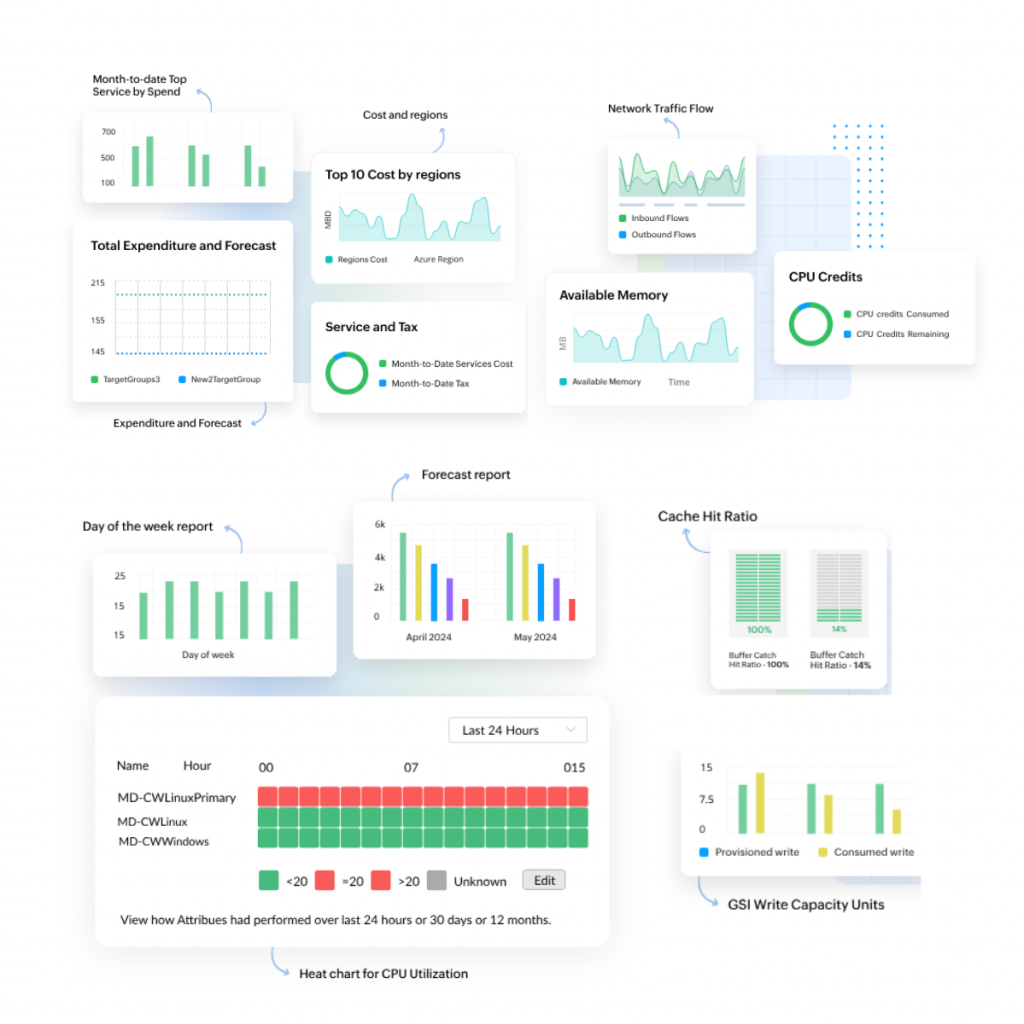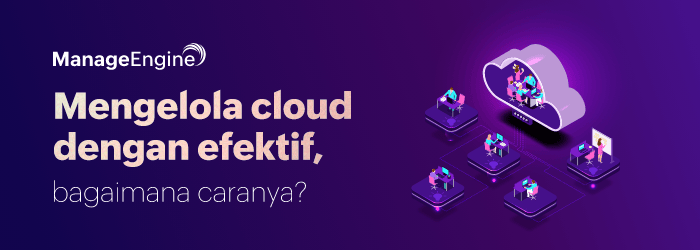The cloud promises scalability, agility, and cost-efficiency, but its dynamic nature presents significant monitoring challenges. As businesses increasingly rely on cloud-based applications and infrastructure, the need for robust monitoring has never been more critical. This blog explores the complexities of cloud monitoring, the limitations of native tools, and how ManageEngine Applications Manager can provide a comprehensive solution.
Obstacles to effective cloud management
Navigating the cloud landscape is not without challenges. Here are some common hurdles organizations face:
Complexity of distributed systems
Cloud environments are intricate, distributed systems composed of numerous interconnected components spread across diverse geographic regions. With this complexity, it’s difficult to obtain a unified view of performance and health. Traditional monitoring approaches struggle to manage the dynamic nature of cloud resources effectively, often resulting in blind spots and performance degradation. To better monitor cloud environments, organizations should understand performance interdependencies and competently correlate data from various sources to identify root causes and potential issues.
Scalability
The rapid expansion of cloud infrastructure to accommodate growing business demands presents a significant challenge. As organizations scale their operations, the complexity of their cloud environments increases exponentially. This accelerated growth often outpaces the ability to maintain comprehensive visibility across all resources. Consequently, critical blind spots can emerge, leaving systems vulnerable to performance degradation, security breaches, and unexpected costs.
Dynamic nature of cloud resources
The constantly fluctuating nature of cloud resources makes it challenging to ensure consistent and comprehensive monitoring. As resources are dynamically provisioned and deprovisioned, tracking their life cycle and ensuring adequate monitoring coverage becomes increasingly complex. This dynamic landscape leads to gaps in visibility, potentially impacting performance, security, and cost optimization.
Integration with on-premises systems
The convergence of on-premises infrastructure and cloud services in hybrid environments creates a complex and heterogeneous IT landscape. Effectively monitoring these disparate systems, each with its unique characteristics and management tools, presents a formidable challenge. Ensuring consistent visibility, performance, and security across both on-premises and cloud resources requires sophisticated monitoring solutions capable of bridging the gap between these distinct environments.
The importance of cloud monitoring
Cloud monitoring is imperative for organizations seeking to optimize cloud investments and mitigate operational risks. By providing real-time visibility into system performance, security posture, and cost consumption, cloud monitoring empowers businesses to make data-driven decisions that enhance efficiency, reliability, and compliance. A robust monitoring strategy is essential for maintaining service levels, safeguarding sensitive information, and maximizing the return on cloud investments.
Ensuring performance and availability
Cloud monitoring is indispensable for maintaining high performance and availability of applications and services. By continuously tracking key metrics such as response times, error rates, and resource utilization, organizations can identify and address performance bottlenecks proactively. Early detection of potential issues enables timely interventions, prevents service disruptions, and ensures a seamless user experience.
Moreover, cloud performance monitoring helps maintain high availability by detecting and responding to system failures or outages promptly. By implementing robust monitoring solutions, organizations can minimize downtime, recover from incidents quickly, and ensure business continuity.
Security and compliance
Cloud monitoring plays a crucial role in safeguarding sensitive data and ensuring compliance with industry regulations. By analyzing system logs and network traffic, organizations can identify suspicious activities, potential security threats, and unauthorized access attempts. Real-time monitoring enables swift response to incidents, minimizing the impact of security breaches. By tracking system configurations, access controls, and data handling practices, organizations can ensure adherence to regulatory requirements and mitigate the risk of penalties.
Resource utilization and cost optimization
Cloud monitoring is instrumental in optimizing cloud costs. By providing visibility into resource utilization, organizations can identify underutilized or idle resources and take corrective actions. This includes rightsizing instances, consolidating workloads, and implementing cost-saving strategies. Additionally, monitoring helps detect cost anomalies and billing errors, preventing unnecessary expenses.
Analyzing usage patterns enables organizations to forecast future resource requirements and adjust capacity accordingly, thereby avoiding overprovisioning and associated costs. Effective cloud monitoring empowers businesses to maximize the return on their cloud investments while maintaining optimal performance.
Best practices in cloud monitoring
Comprehensive cloud monitoring is essential for driving business success. By providing actionable insights into performance, security, and cost efficiency, it empowers organizations to optimize cloud investments and mitigate risks. With robust monitoring solutions and best practices, businesses can achieve greater agility, reliability, and competitive advantage in the dynamic cloud landscape.
Learn more about cloud monitoring and how to optimize performance, enhance security, and maximize cost efficiency from our blog titled Best practices for your cloud monitoring strategy.
Limitations of native cloud monitoring tools
While native cloud monitoring tools offer a basic level of visibility, they often fall short in addressing the complex needs of modern organizations. Here are some key limitations:
Fragmented view in multi-cloud environments
Native cloud monitoring tools often provide a siloed view of the cloud environment, limiting visibility to a specific platform. This can be problematic for organizations utilizing a multi-cloud strategy, as it creates a fragmented monitoring landscape.
Data silos
Native cloud monitoring tools often create data silos, isolating monitoring data within the confines of each cloud platform. This fragmentation hinders a comprehensive view of the overall cloud environment, making it challenging to correlate metrics, identify root causes of issues, and optimize resource utilization across different cloud providers.
Lack of customization
Native cloud monitoring tools often offer a predefined set of metrics and alerts, which may not align perfectly with the unique requirements of specific business applications and services. This lack of customization can lead to critical monitoring gaps, as organizations are unable to track the specific performance indicators and thresholds essential for their operations.
Implementing and managing native cloud monitoring tools can be a time-consuming and resource-intensive endeavor, especially in complex, multi-cloud environments. Complex configurations, ongoing maintenance, and troubleshooting can divert valuable IT personnel from strategic initiatives. This operational overhead can delay the implementation of a comprehensive monitoring strategy, leaving organizations vulnerable to performance issues and security risks.
Mastering cloud complexity with ManageEngine Applications Manager
ManageEngine Applications Manager is a comprehensive monitoring solution designed to conquer the challenges inherent in managing complex cloud environments. By delivering robust features and capabilities that surpass traditional monitoring tools, Applications Manager empowers organizations to achieve optimal performance, security, and cost-efficiency.

Key benefits of Applications Manager
-
Unified visibility across clouds: Supports monitoring of diverse cloud environments, including AWS, Azure, Google Cloud, and more, providing a consolidated view of resources across different platforms.
-
Comprehensive performance insights: Monitors the performance of cloud-hosted applications, databases, and services. This solution tracks critical performance indicators such as response time, CPU utilization, memory consumption, disk I/O, and network traffic to identify bottlenecks and optimize performance.
-
Continuous monitoring: Automatically detects new cloud resources through its Automatic Discovery and Dependency Mapping (ADDM) feature that incorporates them into the monitoring environment and ensures comprehensive coverage without manual intervention.
-
Resource utilization and optimization: Identifies underutilized resources and makes educated decisions with the help of forecast reports that predict resource usage and growth. With this, you can optimize cloud resource allocation to ensure maximum efficiency and ROI.
-
Proactive issue management: Configures static as well as dynamic threshold-based alerts for critical performance metrics. This enables timely responses to potential issues. Supports diverse notification channels, including email, SMS, and integrations with third-party collaboration tools such as Slack.
-
Holistic dashboards: Provides a comprehensive view of your entire cloud ecosystem, including multi-cloud and hybrid environments, through a single pane of glass.
-
Customization options: Personalizes monitoring to specific business needs with custom metrics, dashboards, and alerts.
-
Seamless integration: Achieves consistent monitoring across on-premises and cloud resources.
-
Accelerated time-to-value: Simplifies setup and maintenance with intuitive workflows and automation.
-
Optimized costs: Identifies cost-saving opportunities and prevents wasteful spending through efficient monitoring of services being used.
By harnessing the power of Applications Manager, organizations can effectively navigate the complexities of cloud monitoring and unlock the full potential of their cloud investments, regardless of whether they are using public, private, or hybrid clouds.

